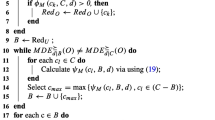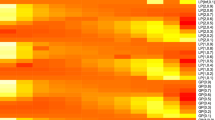Abstract
This paper describes the application of evolutionary fuzzy systems for subgroup discovery to a medical problem, the study on the type of patients who tend to visit the psychiatric emergency department in a given period of time of the day. In this problem, the objective is to characterise subgroups of patients according to their time of arrival at the emergency department. To solve this problem, several subgroup discovery algorithms have been applied to determine which of them obtains better results. The multiobjective evolutionary algorithm MESDIF for the extraction of fuzzy rules obtains better results and so it has been used to extract interesting information regarding the rate of admission to the psychiatric emergency department.
Similar content being viewed by others
References
Agrawal R, Imieliski T, Swami A (1993) Mining association rules between sets of items in large databases. In: Proceedings of the 1993 ACM SIGMOD international conference on management of data. ACM Press, pp 207–216
Aguilar-Ruiz J, Costa R, Divina F (2004) Knowledge discovery from doctor–patient relationship. In: Proceedings of the ACM symposium on applied computing, vol 1, pp 280–284
Ainon R, Lahsasna A, Wah T (2009) A transparent classification model using a hybrid soft computing method. In: AMS, pp 146–151
Alcalá-Fdez J, Alcalá R, Gacto MJ, Herrera F (2009) Learning the membership function contexts for mining fuzzy association rules by using genetic algorithms. Fuzzy Sets Syst 160(7):905–921
Alhajj R, Kaya M (2008) Multi-objective genetic algorithms based automated clustering for fuzzy association rules mining. J Intell Inform Syst 31(3):243–264
Atzmueller M, Puppe F (2006) SD-Map—a fast algorithm for exhaustive subgroup discovery. In: Proceedings of the 17th European conference on machine learning and 10th European conference on principles and practice of knowledge discovery in databases, vol 4213. Springer, Berlin, pp 6–17
Atzmueller M, Puppe F, Buscher HP (2004) Towards knowledge-intensive subgroup discovery. In: Proceedings of the Lernen—Wissensentdeckung—Adaptivität—Fachgruppe Maschinelles Lernen, pp 111–117
Atzmueller M, Puppe F, Buscher HP (2005) Profiling examiners using intelligent subgroup mining. In: Workshop on intelligent data analysis in medicine and pharmacology, pp 46–51
Baca-Garcfa E, Perez-Rodriguez M, Basurte-Villamor I, Saiz-Ruiz J, Leiva-Murillo J, Prado-Cumplido MD, Santiago-Mozos R, ArtTs-Rodrfguez A, Leon JD (2006) Using data mining to explore complex clinical decisions: a study of hospitalization after a suicide attempt. J Clin Psychiatry 67(7):1124–1132
Baca-Garcia E, Perez-Rodriguez M, et al (2008) Patterns of mental health service utilization in a general hospital and outpatient mental health facilities: analysis of 365,262 psychiatric consultations. Eur Arch Psychiatry Clin Neurosci 258(2):117–123
Botta A, Lazzerini B, Marceloni F, Stefanescu DC (2009) Context adaptation of fuzzy systems through a multi-objective evolutionary approach based on a novel interpretability index. Soft Comput 13(5):437–449
Bulbena A, Sperry L, Garcia-Ribera C, Merino A, Mateu G, Torrens M, San-Gil J, Cunillera J (2009) Impact of the summer 2003 heat wave on the activity of two psychiatric emergency departments. In: Actas Esp. Psiquiatr., vol 37, pp 158–165
Casillas J, Carse B (2009) Special issue on genetic fuzzy systems: recent developments and future directions. Soft Comput 13(5):417–418
Chen CH, Hong TP, Tseng VS (2009a) An improved approach to find membership functions and multiple minimum supports in fuzzy data mining. Expert Syst Appl 36(6):10,016–10,024
Chen CH, Hong TP, Tseng VS, Lee CS (2009b) A genetic-fuzzy mining approach for items with multiple minimum supports. Soft Comput 13(5):521–533
Clark P, Niblett T (1989) The CN2 induction algorithm. Mach Learn 3:261–283
Clercq MD, Lamarre S, Vergouwen H (1998) Emergency psychiatry and mental health policy: an international point of view. Elsevier, Amsterdam
Cordón O, Gomide F, Herrera F, Hoffmann F, Magdalena L (2004) Ten years of genetic fuzzy systems. Current framework and new trends. Fuzzy Sets Syst 14:5–31
Cordón O, Alcalá R, Alcalá-Fdez J, Rojas I (2007) Special issue on genetic fuzzy systems: what’s next? Editorial. IEEE Trans Fuzzy Syst 15(4):533–535
Deb K (2001) Multi-objective optimization using evolutionary algorithms. Willey, New York
del Jesus MJ, González P, Herrera F, Mesonero M (2007a) Evolutionary fuzzy rule induction process for subgroup discovery: a case study in marketing. IEEE Trans Fuzzy Syst 15(4):578–592
del Jesus MJ, González P, Herrera F (2007b) Multiobjective genetic algorithm for extracting subgroup discovery fuzzy rules. In: Proceedings of the IEEE symposium on computational intelligence in multicriteria decision making. IEEE Press, pp 50–57
Drobics M, Botzheim J, Koczy L (2007) Increasing diagnostic accuracy by meta optimization of fuzzy rule bases. In: IEEE international conference on fuzzy systems
Fayyad UM, Irani KB (1993) Multi-interval discretization of continuous-valued attributes for classification learning. In: 13th international joint conference on artificial intelligence, pp 1022–1029
Fayyad UM, Piatetsky-Shapiro G, Smyth P (1996) From data mining to knowledge discovery: an overview. In: Advances in knowledge discovery and data mining. AAAI/MIT Press, pp 1–34
Fogel G (2008) Computational intelligence approaches for pattern discovery in biological systems. Brief Bioinform 9(4):307–316
Gacto MJ, Alcalá R, Herrera F (2009) Adaptation and application of multi-objective evolutionary algorithms for rule reduction and parameter tuning of fuzzy rule-based systems. Soft Comput 13(5):419–436
Gamberger D, Lavrac N (2002) Expert-guided subgroup discovery: methodology and application. J Artif Intell Res 17:501–527
Gamberger D, Lavrac N (2003) Active subgroup mining: a case study in coronary heart disease risk group detection. Artif Intell Med 28(1):27–57
Gamberger D, Lavrac N, Krstaic A, Krstaic G (2007) Clinical data analysis based on iterative subgroup discovery: experiments in brain ischaemia data analysis. Appl Intell 27(3):205–217
Goldberg DE (1989) Genetic algorithms in search, optimization and machine learning. Addison-Wesley Longman Publishing Co, London
Grosskreutz H, Rueping S (2009) On subgroup discovery in numerical domains. Data Min Knowl Discov 19(2):210–216
Han J, Pei J, Yin Y (2000) Mining frequent patterns without candidate generation. In: Proceedings of the 2000 ACM SIGMOD international conference on management of data. ACM Press, pp 1–12
Herrera F (2008) Genetic fuzzy systems: taxomony, current research trends and prospects. Evol Intell 1:27–46
Hong TP, Chen CH, Wu YL, Lee YC (2006) A GA-based fuzzy mining approach to achieve a trade-off between number of rules and suitability of membership fuctions. Soft Comput 10(11):1091–1101
Hüllermeier E (2005) Fuzzy methods in machine learning and data mining: status and prospects. Fuzzy Sets Syst 156(3):387–406
Ishibuchi H (2007) Multiobjective genetic fuzzy systems: review and future research directions. In: IEEE international conference on fuzzy systems, pp 913–918
Jovanoski V, Lavrac N (2001) Classification rule learning with APRIORI-C. In: 10th Portuguese conference on artificial intelligence on progress in artificial intelligence, knowledge extraction, multi-agent systems, logic programming and constraint solving, vol 2258. Springer, Berlin, pp 44–51
Kavsek B, Lavrac N (2006) APRIORI-SD: adapting association rule learning to subgroup discovery. Appl Artif Intell 20:543–583
Kaya M (2006) Multi-objective genetic algorithm based approaches for mining optimized fuzzy association rules. Soft Comput 10(7):578–586
Kielan K, Kucharska-Pietura K, Warchala A, Konopka M, Pieniazek P, Hartel M (2004) “saba”—application of knowledge and state-of-the-art technologies in the field of psychiatry for development of new diagnostics prevention and therapeutic tools for schizophrenia. In: vol 57(1), pp 152–157
Kloesgen W (1996) Explora: a multipattern and multistrategy discovery assistant. In: Advances in knowledge discovery and data mining. American Association for Artificial Intelligence, pp 249–271
Kralj P, Lavrac N, Gamberger D, Krstaic A (2007) Contrast set mining through subgroup discovery applied to brain ischaemina data. In: 11th Pacific-Asia conference on knowledge discovery and data mining, vol 4426. Springer, Berlin, pp 579–586
Lavrac N, Flach PA, Zupan B (1999) Rule evaluation measures: a unifying view. In: Proceedings of the 9th international workshop on inductive logic programming, vol 1634. Springer, Berlin, pp 174–185
Lavrac N, Flach P, Kavsek B, Todorovski L (2002) Rule induction for subgroup discovery with CN2-SD. In: Proceedings of the 2nd international workshop on integration and collaboration aspects of data mining, decision support and meta-learning, pp 77–87
Lavrac N, Cestnik B, Gamberger D, Flach PA (2004a) Decision support through subgroup discovery: three case studies and the lessons learned. Mach Learn 57(1–2):115–143
Lavrac N, Kavsek B, Flach PA, Todorovski L (2004b) Subgroup Discovery with CN2-SD. J Mach Learn Res 5:153–188
López B, Barrera V, Meléndez J, Pous C, Brunet J, Sanz J (2009) Subgroup discovery for weight learning in breast cancer diagnosis. In: Proceedings of the 12th conference on artificial intelligence in medicine, vol 5651. LNAI, pp 360–364
Mantzaris D, Anastassopoulos G, Iliadis L, Adamopoulos A (2009) An evolutionary technique for medical diagnostic risk factors selection. IFIP Int Federation Inform Process 195–203
Masuda G, Sakamoto N, Yamamoto R (2002) A framework for dynamic evidence based medicine using data mining. In: Proceedings of the IEEE symposium on computer-based medical systems, pp 117–122
Michie D, Spiegelhalter DJ, Tayloy CC (1994) Machine learning. Ellis Horwood
Mueller M, Rosales R, Steck H, Krishnan S, Rao B, Kramer S (2009) Subgroup discovery for test selection: a novel approach and its application to breast cancer diagnosis. In: Proceedings of the 8th international symposium on intelligent data analysis, vol 5772. Springer, Berlin, pp 119–130
Nannings B, Bosnian RJ, Abu-Hanna A (2009) A subgroup discovery approach for scrutinizing blood glucose management guidelines by the identification of hyperglycemia determinants in ICU patients. Methods Inform Med 47(6):480–488
Papageorgiou E, Papandrianos N, Apostolopoulos D, Vassilakos P (2008) Fuzzy cognitive map based decision support system for thyroid diagnosis management. In: IEEE international conference on fuzzy systems, pp 1204–1211
Romero C, González P, Ventura S, del Jesus MJ, Herrera F (2009) Evolutionary algorithm for subgroup discovery in e-learning: a practical application using Moodle data. Expert Syst Appl 36:1632–1644
ValdTs J, Barton A, AS Haqqani A (2008) Analysis of mass spectrometry data of cerebral stroke samples: an evolutionary computation approach to resolve and quantify peptide peaks. Genet Program Evol Mach 9(3):257–274
Wrobel S (1997) An algorithm for multi-relational discovery of subgroups. In: Proceedings of the 1st European symposium on principles of data mining and knowledge discovery, vol 1263. Springer, Berlin, pp 78–87
Yardimci A (2009) Soft computing in medicine. Appl Soft Comput J 9(3):1029–1043
Yu L, Wu C, Yeh J, Jang F (2008) HAL-based evolutionary inference for pattern induction from psychiatry web resources. IEEE Trans Evol Comput 12(2):160–170
Zadeh LA (1975) The concept of a linguistic variable and its applications to approximate reasoning. Parts I, II, III. Information Science 8–9:199–249,301–357,43–80
Zelezny F, Lavrac N (2006) Propositionalization-based relational subgroup discovery with RSD. Mach Learn 62:33–63
Zitzler E, Laumanns M, Thiele L (2002) SPEA2: Improving the strength pareto evolutionary algorithm for multiobjective optimization. In: International congress on evolutionary methods for design optimization and control with applications to industrial problems, pp 95–100
Acknowledgments
This work was supported by the Spanish Ministry of Education, Social Policy and Sports under projects TIN-2008-06681-C06-02, and by the Andalusian Research Plan under project TIC-3928.
Author information
Authors and Affiliations
Corresponding author
Rights and permissions
About this article
Cite this article
Carmona, C.J., González, P., del Jesus, M.J. et al. Evolutionary fuzzy rule extraction for subgroup discovery in a psychiatric emergency department. Soft Comput 15, 2435–2448 (2011). https://doi.org/10.1007/s00500-010-0670-3
Published:
Issue Date:
DOI: https://doi.org/10.1007/s00500-010-0670-3




